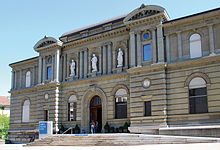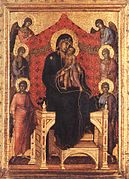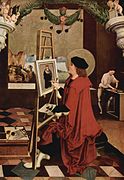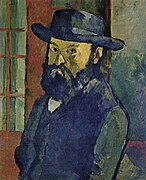Art Museum Bern
| Art Museum Bern | |
|---|---|
 Logo art museum |
|
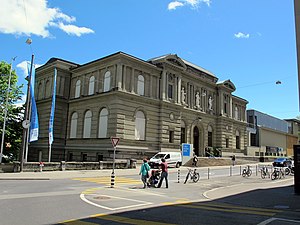 Museum main entrance Hodlerstrasse |
|
| Data | |
| place |
Hodlerstrasse 8–12 3011 Bern Switzerland |
| Art | Art museum |
| architect | Eugene Stettler |
| opening | 1879 |
| Number of visitors (annually) | 97,139 (2016) |
| operator | Roof Foundation Kunstmuseum Bern - Zentrum Paul Klee |
| management | Nina room |
| GLAM | CH-000210 |
| ISIL | CH-000661-6 |
| KGS | 634 + 8509 |
| Website | www.kunstmuseumbern.ch |
The Kunstmuseum Bern is one of the oldest art museums in Switzerland . Since August 2016 it has been run by the art historian Nina Zimmer together with the Zentrum Paul Klee .
history
institution
The roots of the Kunstmuseum Bern lie in art education. The first art school was established in 1779. In 1805 the Bern Academy was founded in the buildings of the former Franciscan monastery . For the plaster casts of ancient statues, which came to Bern as a gift from the French government, an "antique hall" was set up there. The casts laid the foundation for the “State Art Collection”. In 1820, parts of the collection of the busy art journalist and art dealer Sigmund Wagner were purchased. Groups of works by Johannes Dünz , Niklaus Manuel and Joseph Werner the Younger laid the foundation for a "Patriotic Painting Museum".
The Bernische Kunstgesellschaft , founded in 1813, aimed not only at exchanging ideas but also at promoting local art. Their activities included collecting and the regular organization of exhibitions. From 1840 to 1854 it organized a Swiss art exhibition every two years.
Up until 1864, the Bern art collections were spread over various temporary locations: Stations were the late Gothic Antonierhaus, the baroque monastery building near the cathedral or a room in the Erlacherhof. In 1849 the State Art Collection was finally merged with the collection of the Art Society and shown in the choir of the French Church . This year marks the actual founding of the Kunstmuseum Bern. From 1864 the collection was on display for fifteen years in the west wing of the newly built Federal Palace.
In 2015 the umbrella foundation Kunstmuseum Bern - Zentrum Paul Klee was established, giving the two Bern institutions joint strategic management.
building
The building of the art museum at Hodlerstrasse 8-12 was built between 1876 and 1878 under Eugen Stettler and in 1879 he moved into it. The magnificent Wilhelminian-style building based on the neo-renaissance design by Stettler was built on the edge of the historic city plateau as an urban counterpart to the Federal Palace. On the facade, two round medallions by Raphael Christen represent Zeus and Minerva . From 1932 to 1936 a new-object, modern side wing was built under the architects Karl Indermühle and Otto Salvisberg , which was directly connected to the Stettler building. The building, which opened on February 29, 1936, had undecorated white walls that were illuminated by skylights on the upper floor - ideal architecture for contemporary modernism, which was only to find its way there later. Instead, Swiss artists dominated at the time of its creation, who paid homage to the zeitgeist of “ spiritual national defense ” with a rustic realism . The building decoration - a sgraffito on the facade facing Hodlerstrasse with the theme of "Apple Harvest" by Cuno Amiet - was carried out accordingly . Bernese artists who represented progressive currents protested with a nightly tar attack on the sgraffito. A second expansion with additional areas for the collection, a cinema, office, seminar and library rooms as well as a café in place of the so-called Salvisberg building was carried out in 1983 by the Bern architecture collective Atelier 5 . The extension of Indermühle / Salvisberg was canceled with the exception of the street front. The basement floors were extended by several floors into the slope. The former street facade, a closed wall, was left in place and a sheet-metal clad, simple steel construction was added. As early as 1993, the Atelier 5 building had to undergo an urgent structural renovation. The renovation of the historic staircase hall in the Stettler building was completed in 1999.
In 2006 a project competition for an extension was carried out in order to expand the exhibition space, especially for contemporary art, and to ensure safe delivery. The two projects that won the first prize, «cultivated» and «Scala», failed - the first due to the preservation of monuments, the second due to cost reasons. A modernization project that included the renovation and expansion of the A5 building failed in 2017 due to the award procedure. An internal renovation of the Atelier 5 building planned for 2018–2020, which would have been made possible by the move out of the Art History Institute of the University of Bern, has also been suspended. In the autumn of 2017, Hansjörg Wyss announced his support for an expansion of the Kunstmuseum Bern for contemporary art in the event that the “cultivated” project would still be implemented. This was followed by discussions on the part of the museum, the city and the canton. A feasibility study was carried out in 2018 with the help of architecture experts. Important topics of the study were an urban upgrading of the Hodlerstrasse, as well as the known urgent need for renovation of the extension building. In the summer of 2019, talks were held with all cantonal and municipal authorities, administrations, partners, associated foundations, support associations, organizations of Bernese culture, monument preservation, heritage protection, architectural and business associations and public panels were held under the title “Future KMB”. The results have been incorporated into a project dossier with three proposed solutions, which form the basis for decision-making for financing and an architecture competition.
collection
The collection ranges from Gothic to the present day . It comprises over 4,000 paintings and sculptures , as well as around 48,000 drawings , prints , photographs , videos and films . The area of classical modernism in particular is considered to be of international importance. A dozen paintings that were acquired by the Canton of Bern in 1820 form the basis of the collection . Further emphases are the Italian Trecento (e.g. Duccio di Buoninsegna ), Bernese art since the 15th century ( Niklaus Manuel , Albert Anker , Ferdinand Hodler ), French art from Eugène Delacroix and Gustave Courbet to Salvador Dalí and André Masson , the German Expressionism around Ernst Ludwig Kirchner and more recent art movements from Jackson Pollock to the present day.
When the former director of the Kunsthalle, Max Huggler , became director of the Kunstmuseum Bern in 1944, the focus of the collection shifted towards a more international profile. Huggler declared Paul Klee to be the “vegetation point” of his collection policy . After the death of Lily Klee , Paul Klee's widow, a group of Bernese collectors founded the Klee Society in 1946, from which the Paul Klee Foundation emerged a year later. The extensive holdings were kept in the Kunstmuseum Bern from 1952. In 2005, a large part of Paul Klee's work was transferred to the Zentrum Paul Klee , which opened on June 20, 2005. Since then, the spectacular architecture by Renzo Piano has housed around 4,000 works, the world's most important collection of paintings, watercolors and drawings by Paul Klee, as well as archives and biographical materials from all of Klee's creative periods. However, there are still works by the artist in the collection of the Kunstmuseum Bern, such as his masterpiece from 1932, Ad Parnassum .
In addition to the purchases made by the Kunstmuseum Bern itself, the extensive collection consists mainly of generous private and institutional donations, bequests and permanent loans. Hans Hahnloser , son of the Winterthur collector couple Arthur Hahnloser and Hedy Hahnloser-Bühler , who taught art history in Bern, donated Félix Vallotton's “L'Enlèvement d'Europe” in 1946 and Vincent van Gogh's “Faded Sunflowers” to the museum in 1946 . Huggler was also on friendly terms with the art dealer and collector Georges F. Keller. In 1952, part of the Keller collection came to the house as a deposit. When Keller died, the collection - including major works by Paul Cezanne , Edgar Degas , Pierre Auguste Renoir , Henri Matisse , Chaïm Soutine , Pablo Picasso and Salvador Dalí - was transferred to the Kunstmuseum Bern.
In 1954, the collection of the Bern merchant Hermann Rupf , which includes works by Picasso , Georges Braque and the Fauves as well as extensive groups of works by Fernand Léger , Juan Gris and André Masson , was entrusted to the Bern Art Museum and transferred to a foundation. In 1961 the Ernst Kreidolf Association deposited his works in the Bern Art Museum. In addition, donations from Nell Walden and Marguerite Arp-Hagenbach from the 1960s onwards expanded the collection. The estate of Adolf Wölfli has been in the Kunstmuseum Bern since 1975 . In 1979 top works by Picasso, Klee, Franz Marc , Alexej von Jawlensky and Wassily Kandinsky came to the art museum as a deposit with the Othmar Huber Foundation . The foundation of the Bernese collector couple Anne-Marie and Victor Loeb closed the gaps in the area of the with outstanding works by Johannes Itten , Victor Vasarely , Camille Louis Graeser, Max Bill and Richard Paul Lohse , by Fucio Fontana and Piero Manzoni , Jean Tinguely and Jesús Rafael Soto constructive art as well as the post-war avant-garde.
In the 1980s, the Kunstmuseum Bern received the Meret Oppenheim legacy as well as numerous donations, for example from Eberhard W. Kornfeld and Marlies H. Kornfeld.
In 1992 the Johannes Itten Foundation joined the Kunstmuseum Bern. The foundation's assets are deposited in the art museum and include more than 100 works by Johannes Itten as well as diaries and student work from his lessons.
In the last few decades, the collection of the Kunstmuseum Bern has grown to include works of contemporary art, thanks in part to donations from the Bern gallery owner and collector Toni Gerber and the Kunst heute foundation, as well as partnerships with new foundations. With the holdings of its partner foundations GegenwART, Kunsthalle Bern and the Bern Foundation for Photography, Film and Video, the Kunstmuseum Bern has one of the most important contemporary collections in Switzerland.
gallery
Duccio di Buoninsegna , Maestà, around 1290–1295
Niklaus Manuel Deutsch :
Saint Luke paints the Madonna , 1515Albert Anker :
The Drinker , 1868Paul Cézanne :
Self-Portrait , 1879–1882Ferdinand Hodler :
The Day , 1900Adolf Wölfli : The Skt-Wandanna-Cathedral in Band-Wand , 1910
Franz Marc :
Blue Horse II , 1911August Macke :
Garden restaurant , 1912Alexej von Jawlensky : Pensive Woman , 1913
Lovis Corinth : Self-Portrait with the Straw Hat , 1923
Paul Klee :
Ad Parnassum , 1932
Gurlitt Collection
In 2014 the Kunstmuseum Bern inherited the estate of Cornelius Gurlitt . The first department for provenance research in Switzerland was then set up, which is primarily financed by grants from private foundations.
The legacy raises a number of legal and ethical questions. So far, only works with secured title have reached Bern. The Munich District Court and the Bavarian Ministry of Justice emphasized that the museum inherits not only the pictures, but also the obligations associated with them . The museum must therefore also comply with the agreement on provenance research that Gurlitt signed at the beginning of April . All paintings suspected of being looted would then remain in state custody in Germany for an indefinite period of time. There they would be analyzed by researchers and claims made by heirs of victims of the Nazi regime at the time. According to the researchers of the Task Force Schwabinger Kunstfund entrusted with the origin analysis , around 400 works from Gurlitt's collection are suspected of being looted art. In the meantime, five relatives of Gurlitt's supported the deceased collector's wish to give his collection to Switzerland. In doing so, they opposed their great cousin Ekkehard Gurlitt, who voted to keep the works of art in Bavaria.
The Bavarian Ministry of Art announced in 2014 that the Gurlitt collection had to be checked for its significance for German cultural assets and pointed to the law on the protection of German cultural assets against emigration, which could take effect. The German Cultural Property Protection Act (KGSG) states that works that are listed in the “Directory of Nationally Valuable Cultural Property” require official approval when exported abroad.
On November 22, 2014, the Board of Trustees of the Kunstmuseum Bern decided to take on the Gurlitt estate, which was made public two days later at a press conference in Berlin.
Starting in November 2017, the Kunstmuseum Bern presented a selection of works from the estate of Cornelius Gurlitt in a double exhibition together with the Bundeskunsthalle in Bonn . Under the title “Gurlitt inventory. - Degenerate Art - Confiscated and Sold "and" Gurlitt Inventory Part 2. - The Nazi Art Theft and the Consequences "the Kunstmuseum Bern showed around 160 works, most of which had been confiscated as" degenerate art "in German museums. For the first time, the works that the art dealer Hildebrand Gurlitt acquired in the 1930s and 1940s were shown in a historical context.
Movies
- Museum check with Markus Brock : Kunstmuseum Bern and Zentrum Paul Klee. Synopsis and video from 3sat . First broadcast: December 3, 2017
See also
Web links
- Official website of the Kunstmuseum Bern
- Kunstmuseum Bern on the "Bern Tourism" website
- Kunstmuseum Bern on the "Museums Bern" website
- Website of the Paul Klee Center
Individual evidence
- ^ Annual report 2016 Kunstmuseum Bern. In: Annual report. Kunstmuseum Bern, June 9, 2017, p. 45 , accessed on March 19, 2018 (Combined Annual Report Kunstmuseum Bern, Zentrum Paul Klee and Creaviva; PDF from p. 1. PDF download 1.2 MB. Number of visitors 2016 p. 40; without "Other visitors (Shop / Café / PROGR)").
- ↑ Nina Zimmer becomes the new Super Director. Tagesanzeiger.ch, March 22, 2016
- ↑ Rudolf Burger, Brigitta Niederhauser: "I don't want to stop with a defeat" . derbund.ch., August 25, 2009, accessed on May 9, 2014.
- ↑ Ad Parnassum - The exhibition around the masterpiece. : paulkleezentrum.ch, accessed on May 10, 2014.
- ↑ The Gurlitt Collection comes to Bern: Like a bolt from the blue. In: Neue Zürcher Zeitung . May 7, 2014, accessed May 9, 2014 .
- ↑ Dispute over will: Gurlitt relatives support decision for Switzerland. In: Spiegel Online . May 23, 2014, accessed May 23, 2014 .
- ↑ Gurlitt Collection goes to Bern ( Memento from May 7, 2015 in the Internet Archive ), tagesschau.de from May 7, 2014, accessed on May 10, 2014.
- ↑ Michael Sontheimer: Gurlitt Collection in Switzerland: Taskforce “Ahnungslos”. At Spiegel Online, November 24, 2014 (accessed November 25, 2014).
- ^ Kunstmuseum Bern: Gurlitt inventory of “Degenerate Art” - confiscated and sold. Archived from the original ; accessed on February 24, 2018 .
